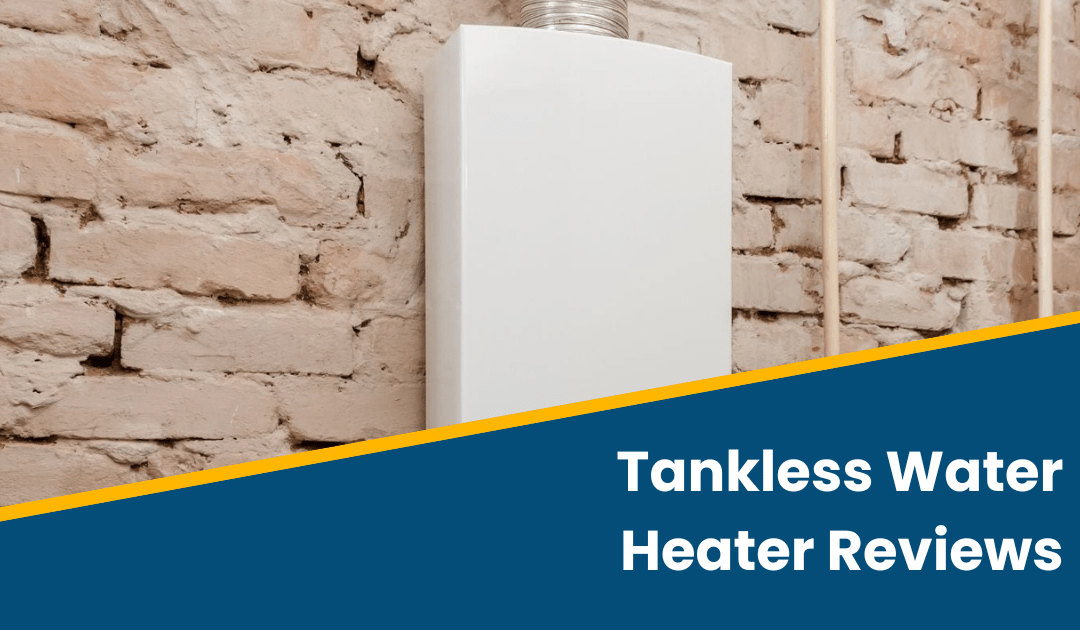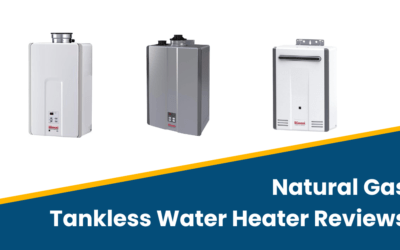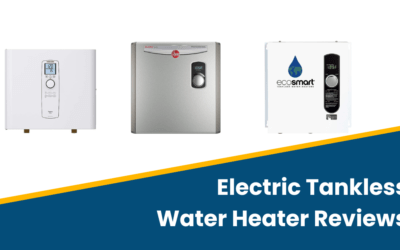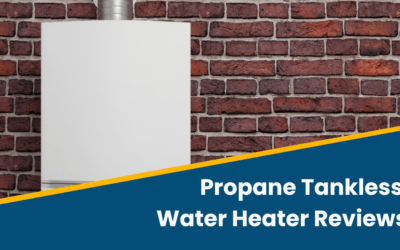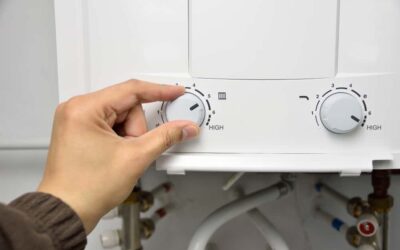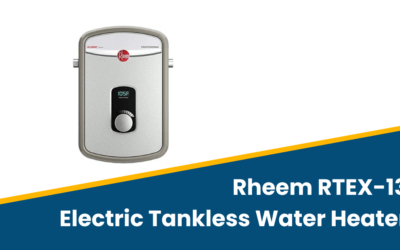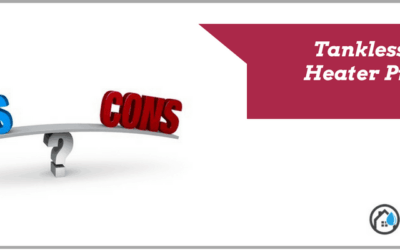BEST ELECTRIC
Stiebel Eltron Tempra Plus 29 kW
BEST NATURAL GAS
Rinnai V75IN Tankless Hot Water Heater
BEST PROPANE
Rinnai RL75IP Propane Tankless Water Heater
In the market for a new tankless water heater?
If you are researching tankless water heaters, then you have probably already heard about most of the benefits they have to offer. For example, a tankless water heater can reduce your water heating bill by as much as 24% to 35% – if your household uses less than 41 gallons of hot water each day. It is likely you are also familiar with the fact that they possess the potential to offer an unlimited source of continuous water.
Because they are not restricted by a tank size, there are no limits to the amount of water you can access. In short, purchasing a tankless heater is one of the smartest investments you can make in your home.
Tankless water heaters use one of three power sources. You can read more reviews for each of these at the links below.
- Electric tankless water heater reviews
- Natural gas tankless water heater reviews
- Propane tankless water heater reviews
For decades, tankless water heaters have been the standard in Europe and other parts of the world; however, only in the last decade has North America seen a significant increase in interest. The downside to this newfound interest is that the market has quickly become saturated with many models as manufacturers hurry to jump on the bandwagon.
Unfortunately, many companies have cranked out their versions of tankless water heaters without investing the time and effort required to properly develop and engineer them. This oversaturation of the market makes it difficult to determine which models are worthwhile. Moreover, because tankless models have a high upfront cost, the stakes are high to pick the perfect model for your home.
The good news is that you have come to the right place! We have invested the time, read all of the tankless water heater reviews – and have done all the research for you.
Here is your one stop resource for all of the information you need to make an informed buying decision. Whether you live by yourself or are a member of a large family, we will help you find the perfect model that suits your individual needs, tastes, and budget.
5 Best Tankless Water Heaters for 2023
BEST ELECTRIC
Stiebel Eltron Tempra Plus 29 kW
The Stiebel Eltron Tempra Plus 29 kW boasts itself as the most technologically advanced water heater that is available on the market. The Tempra Plus promises to give its users a satisfactory experience every single time you use it by eliminating temperature fluctuation.
Unlike some other tankless water heater options that are available, the Tempra Plus uses Advanced Flow Control technology that can accurately adjust water flow, so the temperatures remain consistent. No more showers that end up leaving you rinsing off in chilly water or having to worry about touching scalding water while doing the dishes.
The Tempra series of Steibel Eltron water heaters are favorably known for their low energy consumption. Gas tankless water heaters can be quite expensive to install in your home because you often have to enlist the help of a professional. With the Tempra Plus, the installation will be much more of a breeze because you don’t have to worry about creating an outside vent for this electric-style heating system.
Electric tankless heaters usually cost less than their gas-using counterparts, so you will save money upfront after purchasing your Stiebel Eltron Tempra Plus 29kW, and will continue to see savings in your electric bill long after your initial installation of this tankless heating system. Compared to standard tank systems, the Tempra Plus can help save an extra 20% in utility usage.
Features:
- Digital temperature display that allows for you to adjust the water temperature output to be heated between 86 and 125 Fahrenheit.
- Advanced Flow Control technology automatically adjusts the flow of output so that water temperatures remain consistent.
- The Tempra Plus 24 has a robust heating system that is well suited for large homes and houses that are in relatively cold climates.
- Has a max power of 24 kW on 240 V, which is excellent for powering the entire house. For average size houses, there is no need to purchase multiple electric water heaters so that you can adequately heat the water throughout your home.
- The Tempra 24 has a Compact and sleek design that is suitable for a great deal of residential and commercial needs.
Pros:
- The Tempra Plus 24 is built with two electric heating modules that are equipped to handle heavy hot water demands.
- Steel coated encasings protect the product parts and are designed to resist corrosion and help to boost up the functional lifetime of your water heater.
- The small and compact design makes the Tempra Plus 24 a fantastic electric tankless water heating option regardless of if you own a large single-family home or a single-bathroom condominium.
Cons:
- The Limited warranty coverage only lasts for three years and is relatively short in contrast to some of the Tempra Plus 24’s competitors who offer lifetime coverage.
- Compared to some other electric tankless water heater reviews, The Tempra Plus 24 has had some complaints in regards to having a relatively low water pressure.
- While it is an attractive option in contrast to gas-powered tankless systems since there is no need for a vent in your home, the Tempra 24 Plus has some power operating features that may require you to make upgrades to your home’s electrical system.
BEST NATURAL GAS
Rinnai V75IN Tankless Hot Water Heater
For those yearning for efficiency, compactness, and an unceasing supply of hot water, the Rinnai V75IN Tankless Hot Water Heater should rank high on your shortlist. The allure of the Rinnai V75IN is not just its energy conservation ethos. Not only does it save energy by heating water only when needed, but its compact design also makes it fit easily into most homes. This tankless hot water heater is a savoir against those infuriating moments when you’re ensconced in a warm shower and suddenly the water runs cold. Delivering an impressive 7.5 gallons per minute, it’s akin to having a waterfall at your beck and call. Five fixtures running simultaneously? It’s unfazed. Enhanced scale detection is built in, which mitigates potential long-term damage, ensuring its longevity and consistent performance.
Features:
- Efficiency: Only heats water when you need it with efficient natural gas. This means you save on energy and never run out of hot water.
- Flow Rate: 7.5 gallons per minute
- Warranty: 15 years for the heat exchanger, 5 years for labor, and 1 year for parts.
- WiFi Control: Optional, with the separate Control module.
- Size: At 17.5 x 30 x 13 inches it’s as small as a briefcase. Perfect for homes where space is at a premium.
- Durable: Built-in scale detection reduces long-term damage and extends its life.
- Installation: While it’s designed for easy setup indoors, it’s best installed by a pro. Rinnai even helps you find local technicians.
Who Should Buy It?
The Rinnai V75IN is great for homeowners who want both efficiency and consistent hot water. Especially useful for homes with medium to high water usage.
Pros:
- Energy-efficient, only heats water when necessary
- Compact size, fits in a variety of spaces
- High flow rate, enough for multiple fixtures at once
- Enhanced scale detection for improved longevity
- Comprehensive warranty for added peace of mind
- Optional WiFi control for convenient temperature adjustments
- Trusted brand with a reputation for quality
Cons:
- Professional installation is recommended
- Control module for WiFi control is not included
BEST PROPANE
Rinnai RL75IP Propane Tankless Hot Water Heater
This tankless water heater comes from the number one best selling brand for water heaters in North America, Rinnai.
This may be one of the more expensive propane tankless water heaters in our top 5 picks, but it offers the best water flow, coming in at a whopping 7.5 GPM.
We’ll talk more about water flow and GPM in our buying guide, but for now, it suffices to say that this particular model of water heater is powerful enough to serve even large houses with several occupants. You could comfortably have two showers running simultaneously, AND have hot water-using appliances at work at the same time, such as a dishwasher or a clothes washer.
But it’s worth noting at this point that the actual flow rate depends on the groundwater temperature in your particular area. For more information on this please refer to the map on the product’s Amazon page.
Similarly, this water heater also offers plenty of power output, coming in at 180,000 BTUs. (More on power output and BTUs in our buying guide).
But the stand out feature of this water heater is how you can operate it from your smartphone, thanks to the Control-R 2.0 mobile app. Through this, you can schedule and time your water heating as you see fit, and you can put it into vacation mode if you’re not going to be there for a while.
There are various warranties available on the device, 12 years on the heat exchanger, 1 year for any labor carried out, and 5 years for parts.
And you needn’t be put off by the large price, because you can pay in interest-free instalments upon approval for the Amazon Rewards Visa Card.
Please note there are several different types and models of this water heater on the Amazon page (such as indoor or outdoor units), so if you decide to buy, please ensure that you have selected the one you want.
Pros:
- Great best-selling brand
- Very impressive water flow
- Plenty of power output
- Good warranties available
- Option to pay in installments
Cons:
- Premium product at a premium price
In addition to its customizable controls and ability to produce water on demand, one of the biggest selling points of the ECO 27 is its energy savings. Although this model is not Energy Star certified, it does boast an impressive 99.8% energy efficiency rating. In most instances, it will reduce a home’s energy costs by 50%. For a few homeowners, the savings have been so significant that the water heater has paid for its initial cost within a matter of a few months.
Features
- EcoSmart offers a lifetime warranty on parts.
- The unit has a 99.8% energy efficiency rating.
- Digital temperature controls allow complete control of the water in one degree increments.
- This model is designed to provide endless hot water to larger households.
- All of its components are made from either stainless steel or copper to ensure their longevity and durability.
Pros:
- This model can reduce a home’s energy consumption by up to 50%.
- Designed for cold climates, the ECO 27 can produce 3 gallons of hot water a minute.
- The temperature controls allow the temperature to be set between 80 and 140 degrees Fahrenheit.
Cons:
- Its overall performance is affected by the temperature of the incoming water.
- Should a homeowner choose to install this tankless water heater themselves, EcoSmart will not honor the lifetime warranty on components.
RUNNER UP
Rinnai RU130iN Condensing Tankless Hot Water Heater
There’s an undeniable allure in products that meld efficiency with power, and the Rinnai RU130iN Condensing Tankless Hot Water Heater is one such offering. With the RU130iN, it’s evident that Rinnai is not content resting on its laurels. Beyond the energy savings inherent to tankless water heaters, this unit impresses with its spatial economy. It’s like a guardian, protecting you from those jarring instances when a pleasurable hot shower turns bitterly cold. Boasting a robust 7 gallons per minute, it’s akin to having a river ready to surge at your command. Running multiple fixtures at once? The RU130iN doesn’t even break a sweat. Moreover, the advanced condensing technology ensures maximum efficiency and prolonged heater life.
Features:
- Efficiency: Condensing technology ensures water heats up rapidly, reducing energy usage.
- Flow Rate: A whopping 7 gallons per minute with up to 11GPM variants
- Warranty: 15 years for the heat exchanger, 5 years for labor, and 1 year for parts.
- WiFi Control: Optional, available through the separate Controlr module.
- Size: Compact and streamlined dimensions of 22.05 x 14.76 x 33.86 inches, a space-saver for modern homes.
- Durability: Advanced tech not only ensures efficiency but also guards against wear and tear.
- Installation: Though geared for easy installation indoors, professional installation is recommended.
Who Should Buy It?
The Rinnai RU130iN is tailor-made for households that prioritize energy efficiency without compromising on water flow. It’s especially ideal for homes with significant water needs.
Pros:
- Ultra-efficient, thanks to the condensing technology.
- Space-conscious design, easily fitting into modern homes.
- Unparalleled flow rate supports numerous fixtures simultaneously.
- Designed for longevity with state-of-the-art technology.
- Solid warranty coverage for peace of mind.
- Option for WiFi control for on-the-fly adjustments.
- Renowned brand with a solid track record.
Cons:
- Professional installation is a must for optimal performance.
- Controlr module for WiFi needs to be bought separately.
RUNNER UP
Camplux Outdoor Portable Propane Tankless Water Heater
This is quite possibly the best option for those who love to go camping, or who like to go off-grid and back to nature. It’s a small outdoor water heater with a handle on top so you can place it on a hook out of the way.
Its power output is very modest, at just 28,000 BTU (more on BTUs in our buying guide later). But on the plus side, this means it doesn’t need a whole lot of power to operate. All it needs is two D-cell batteries. Or alternatively, you can plug it into a standard power outlet.
It has a flow rate of 1.2 GPM, which isn’t quite enough to run a clothes washer, but it can handle a dishwasher, or two faucets running at once.
And if your campsite has no external showering facilities, then you can adapt this water heater by pairing it with a 12-volt water pump, and this will noticeably increase the water pressure.
And when you’re shopping for camping necessities, you don’t want to find yourself parting with just as much cash as you would for your house. And the price of this water heater reflects that sentiment and is available at a fraction of the price of water heaters designed for the home.
Pros:
- Very affordable price
- Great for going off-grid
- Decent flow rate
- No electricity required
Cons:
- Doesn’t allow enough hot water for a power shower without a water pump
RUNNER UP
Rheem RTEX-13
If you’ve been researching tankless water heaters for any length of time, you’ve probably come across the Rheem brand. Rheem’s been around for a long time, and their products have a reputation for long-lasting quality.
While the Rheem RTEX-13 might not look as fancy as some of the other water heaters that are available on the market, this product is solidly constructed and is available at a modest price point.
This water heater is suitable for use in residential and commercial settings, but keep in mind that it operates best when used as a point-of-use heater. Many users have used to Rheem RTEX-13 to electrically heat water for their boats, motorhomes, and garages with great success. You can also use it in your home as long as it is located near the fixtures that it feeds into, and is hooked up to no more than three units.
Like a lot of other brands, the RTEX-13 has a small size that can comfortably fit in almost any space, and it can also be a great way to cut back on some of your utility costs.
Features:
- The Rheem RTEX-13 features modulating power consumption, which enables it to provide a steady, continuous water supply while still saving you on energy usage.
- The front panel has red and green LED lights that indicate when the tankless heater has an active element or is in standby mode.
- Water flow rate of up to 4 gallons per minute.
- The RTEX-13 has a temperature-adjusting knob that enables you to quickly and easily adjust water temperature settings to your liking.
- Energy-star certification indicates that this product is highly rated for its efficiency.
Pros:
- Energy-star certification means that you are likely to see a decent amount of savings in your utility bills after purchasing this product.
- You can adjust the water temperature to nine different settings depending on your usage needs.
- The RTEX-13 comes equipped with a 6-gauge prewired power cable to help make installation a breeze.
Cons:
- Homeowners who reside in colder climates may find that the RTEX-13 lacks enough power to heat up water to their liking during winter months.
- Installation may be difficult for someone who hasn’t had a lot of experience with electric and plumbing installation.
- Some users who have hard water have complained of the RTEX-13 struggling with efficiently.
What is a Tankless Water Heater & How Do They Work?
In its most basic definition, a tankless water heater can be defined as an energy efficient type of water heater that produces hot water only as is needed. Because they do not have an attached tank, they do not experience the standby energy losses that traditional storage water heaters do. This conserves both energy and money.
A tankless water heater uses a heating element to heat water directly eliminating the need for a tank. When the hot water element of a faucet is opened, cold water travels to the unit via a pipe. The water is heated by either an electric element or a gas burner. Because of this technology, a tankless water heater can provide your home with an continuous supply of water. It eliminates the need to wait for a traditional 40 gallon tank to fill up with water. However, the output of a tankless water heater is limited by the flow rate of the incoming cold water.
The average tankless water heater will be able to produce approximately 2 to 5 gallons of hot water each minute. A gas or propane powered model will have higher flow rates than even the best tankless electric water heaters; however, there will be times when the largest gas powered models will be unable to meet demand. For example, if the washing machine is being run at the same time someone is taking a shower in the bathroom, a tankless water heater will be stretched to capacity. The solution to this problem would be to install two or more tankless water heaters in parallel with one another so they may simultaneously meet the demand for hot water.
Another option would be to install different tankless water heaters throughout your home for the appliances, like the dishwasher or washing machine, that require a significant amount of hot to warm water.
How Do Tankless Water Heaters Match Up to Traditional Tank Water Heaters?
Understanding the differences between a tankless water heater and a traditional storage heater can be summed up in these categories:
Efficiency
Energy efficiency is one of the primary reasons why an increasing number of homeowners are making the switch to tankless, and this is where the biggest significant difference between the two models exist.
- Storage water heaters with a tank are continuously running. Even when no water is being used, the unit is still using electricity to warm the water it has stored in its tank. That is wasted energy that you are paying for.
- Because a tankless water heater provides hot water only on demand, it conserves energy. The compact design and small size flash heats the water as it is needed.
Convenience
The single largest problem that homeowners have with their water system is running out of hot water, but this problem is limited to tank size. Due to its on demand style of operation, a tankless model doesn’t have this issue.
- A tankless water heater only begins to heat water when a faucet is opened. Within a few seconds, it can raise the temperature of the water to the desired output, and there is no limit to the amount of hot water it can provide.
- The amount of water that a tank water heater can produce is limited to the amount of preheated water it can hold in its tank. If all of the water in the tank is used up, you’re simply out of luck. You must wait until the water heater can refill its tank and reheat the water.
Maintenance & Installation
The cost of installing a tankless water heater can be costly, and this is one of the primary deterrents that make people shy away from embracing this technology. However, as tankless heaters grow in popularity, the cost is slowly beginning to come down.
- Tank water heaters are an outdated technology, and their design is flawed. As a tank is repeatedly heated and cooled, minerals begin to accumulate inside of it. Most traditional water heaters have a lifespan of 5 to 12 years. The average industry warranty for this type of water heater is 6 years.
- Tankless water heaters are significantly more effective. They require a minimal amount of maintenance, and the average lifespan of a tankless heater ranges from 15 to 20 years. The average industry warranty for a tankless model is 15 years.
A Cost Analysis: What to Expect
As with traditional water heaters, prices for tankless water heaters run the gamut from under $1,000.00 to over $3,500.00. According to the website of the U.S. Department of Energy, an electric tankless water heater will save a homeowner an average of $44.00 per year, while a gas or propane powered models will save an average of $108.00 each year. Modern tankless water heaters have a median lifespan of 15 to 20 years. Traditional tank water heaters generally cost in the vicinity of $400.00 to $650.00 and have an average lifespan of 8 to 12 years. Regardless of which option one chooses, water quality, routine maintenance, quality of the installation, and the design and location of the unit will affect its longevity.
If your home is already equipped with the technology required to install a tankless water heater, then you can expect professional installation to cost you in the neighborhood of $750.00 to $1,000.00. If it is not, then be prepared to spend an average of $2,000.00 in addition to the cost of the unit itself. Installation of a tankless water heater requires the following:
- A dedicated gas line that is capable of handling the BTU demand
- Category III, 4 inch steel (the industry standard) venting
- Additional piping if the unit must be relocated
- A dedicated power source with a backup battery
If installation requires the unit to be located outdoors or attached to an exterior wall, then the installation cost can climb even higher. If you are in the process of building a new home, experts strongly encourage you to go ahead and equip your home with the technology required – even if you are only considering buying a tankless water heater. In the long run, it will cost you less.
Dispelling the Myths
The rise in popularity of tankless technology has also led to a rise in misconceptions and myths surrounding them. Before you decide to rush out and buy a tankless water heater, read on to find out the truth about some myths surrounding tankless water heaters.
1. You can simply swap out your traditional hot water heater for a tankless model.
Unfortunately, tankless and storage water heaters differ in their electrical needs, venting requirements, and gas line sizes. Retrofitting is not as straightforward as switching the models. Proper installation by a licensed professional is required to ensure peak performance and safety. A licensed professional will also be able to obtain the necessary permits to install the model.
2. Tankless water heaters heat water to unsafe temperatures.
This is a myth. All modern tankless water heaters are equipped with adjustable thermostats so that users may adjust the temperature to their liking. The thermostat acts as a safeguard against overheating and scalding. The water heated by your tankless water heater will not become unbearably hot unless the thermostat has been set too high.
3. Tankless water heaters deliver instant hot water.
Each tankless model will have a delay before it begins to produce hot water. Generally, this delay is no longer than 15 to 30 seconds – depending on the size of the water heater. The unit requires this time to turn itself on and gauge how much heat it must generate based upon the flow rates. Where the unit is installed in one’s home will also affect how long the delay is. To combat this issue, some homeowners opt to install multiple tankless water heaters or a circulation system to preheat the incoming water.
4. Tankless water heaters are inefficient.
Traditional water heaters have an affixed tank for storing water, which is kept hot via a pilot light. Because the pilot light is always on, it uses a significant amount of energy. For this reason, tank water heaters have a considerably bigger carbon footprint than their tankless cousins. Because it utilizes clean energy at minimal use, a tankless water heater is an eco-friendly option.
5. A tankless water heater won’t supply my home with enough hot water.
A traditional water heater with a 40 gallon tank holds exactly 40 gallons of water. Once those 40 gallons have been used, more water must be reheated. This process can take as long as 30 minutes, which translates to limited availability.
However, a tankless water heater will supply water as long as it is needed. Because there is no storage tank, there is no shortage of hot water. The water is warmed as it passes over the heating element to an outlet. All you have to do is open the faucet. For example, a medium sized whole home tankless water heater will provide enough hot water for four to five people. Since the water is heated on demand, two or more people can shower at one time.
Difference Between Point of Use & Whole House
When homeowners begin shopping for tankless water heaters, one of the first questions they ask is, “Do I need a whole home or point of use model?”
Point of use tankless water heaters are commonly seen in bathrooms and kitchens across Europe, but they are not as popular in North America. A point of use model is more efficient than its whole home cousin because there is a shorter distance between the unit and the fixture it is supplying water to. This reduces the amount of hot water used each time a faucet is opened and eliminates piping losses. With a longer pipe, after you have finished using the water, you have simultaneously used the “hot” water left in the pipe. You have paid for the energy required to heat that water.
Point of use models are smaller than whole home models, and because they are not designed to supply more than one location at a time, they use smaller heaters. Installation costs are usually less expensive than with a whole home model; however, they are primarily intended for small residences. If you own a large home or have a big family, then purchasing a single whole home tankless water heater might be more practical and cost efficient than purchasing multiple point of use heaters. One of the primary reasons why these models are not popular in North America is aesthetics. Many homeowners simply do not like the idea of having a visible water heater in their bathrooms or kitchens.
By comparison, a whole home tankless water heater is a single unit that is designed to provide hot water to an entire household. They are generally installed where a home’s storage water heater was located, so they are not visible to residents. Although they do require significantly more electricity or gas to heat water than one or two point of use models, they are still quite energy efficient. The primary downside to choosing a whole home model is that it will require larger than standard gas pipe (for gas models) or a dedicated electrical service line (for electric models). These requirements can add to the unit’s overall installation cost.
What Size Do I Need?
Properly sizing a tankless water heater for your home is not difficult, but it does require a bit of thought and effort.
1. What is your maximum flow rate?
Although tankless water heaters are often touted as providing an continuous supply of hot water, the party will come to an end if the flow rate exceeds the unit’s ability to heat the incoming water. Simply put, as the demand for water increases (called the flow rates), the water heater’s abilities to adequately heat the water will decrease.
When sizing a tankless hot water heater, the flow rate is one of the factors that must be accounted for. Most on demand water heaters are generally rated based upon the maximum rise in temperature they can provide at a given flow rate.
The flow rate is defined as the specific amount of water that must be heated when using a tankless water heater. It is measured in gallons per minute. If your water heater will need to service multiple applications at once, the max amount of flowing water that the system can adequately heat will need to be calculated. You should never attempt to undersize a tankless water heater in a bid to save money.
Let’s say that you are looking for a point of use tankless water heater that can service a bathroom sink’s water faucet and a showerhead at the same time. The sink faucet has a flow rate of 2.1 gallons per minute (GPM), and the showerhead has a flow rate of 2.8 GPM. In this instance, you will need to look for a tankless water heater that can accommodate a flow rate of 4.9 GPM.
2. Calculate the temperature rise.
Temperature rise is defined as the difference between the incoming water’s temperature and the wanted outcome. For example, if you live in the Southern United States, the average temperature of watering entering into your home’s hot water system would be around 65 degrees Fahrenheit. This number will fluctuate wildly from one climate to the next; however, ground temperature is generally on par with the average yearly air temperature for a given region or community.
After you have familiarized yourself with the incoming water’s temperature, this number should be subtracted from the output temperature you would like to have. For the majority of domestic tasks, like taking a shower or washing clothes, a sufficient temperature output would range from 100 to 120 degrees Fahrenheit. From an average temp of 65 degrees, incoming water would need to be heated by another 55 degrees Fahrenheit in order to reach the top of the target output range.
3. Does your tankless water heater meet your heating requirements?
After determining the flow rate and calculating the temperature rise, your next step will be to start researching specifications for different models of tankless hot water heaters to figure out which size best suits your requirements. The sizing and rating specifications for a standard tankless water heater would be listed as something like 10 gallons per minute (GPM) with a temperature rise of 55 degrees. New tankless water heaters are equipped with smart technology that enables them to self-limit their flow rates in order to meet an established temperature. Although still relatively rare, this models are becoming increasingly popular.
Can I Install It Myself?
In short, you can try…but unless you are a licenced plumber AND electrician, you probably shouldn’t.
There are specific requirements that must be followed when it comes to properly installing a tankless water heater. If you fail to meet the established requirements, it could put your safety in jeopardy, lead to faulty operation, or void the manufacturer’s warranty. Although most manufacturers do provide installation instructions for their water heaters, an increasing number of manufacturers are opting not to honor the warranties they provide if the unit is not installed by a licensed professional.
Requirements for installation will be affected the brand you choose to purchase, the type of unit, and local laws and ordinances. For examples, many communities require homeowners to obtain permits if they decide to install propane or gas powered tankless water heaters. This type of water heater almost always has special venting requirements. A gas powered tankless water heater utilizes fans that pull in air from the outdoors, and it expels gasses via a flue system. Vents may need to be located on a sidewall or the roof. If you plan on purchasing a propane or gas powered model, be prepared to pay for home renovations to accommodate the required venting system.
For tankless water heaters that are powered by electricity, an upgrade to your home’s existing electrical system may be required. It is imperative for your home to have the proper amount of electrical capacity to power the water heater. Most electrical models require their own dedicated power line.
Most manufacturers also have specific requirements regarding where in the home a tankless water heater can be installed. For example, your new water heater will need to be installed in a location where, in the event of accidental leakage, nearby structures and floors will not be affected. Tankless water heaters must be installed in a location where air flow will not be restricted and is well-ventilated.
For these reasons, it is best to skip the DIY route and spend the money to hire a licensed professional to install your tankless water heater. In doing so, you will ensure your own safety and that of your family. You can also rest assured that the manufacturer will honor their warranty.
Pros & Cons
Space saving designs, endless supplies of hot water, and decreased energy bills are just a few of the reasons why an increasing number of homeowners are switching over to tankless water heaters; however, for some individuals, these benefits are not sufficient to entice them to make the switch.
As with most items you’ll buy, tankless water heaters have their own sets of pros and cons.
The upfront cost can be astronomical.
On average, a tankless water heater will cost three times more than a tank model. Depending on the type you purchase and its size, the cost can range from just under $1,000.00 to well over $3,000.00 – and that is just for the unit itself. You must also pay the cost of having a professional plumber install it.
Another factor to consider is that not all homes are equipped to accommodate a tankless water heater. For homeowners who purchase an electric model, their home’s electrical system may need upgrading, which means that money will need to be spent to hire a qualified electrician. It is not uncommon for rewiring your home to add as much as $5,000.00 to the total cost of installation.
Tankless water heaters have longer warranties and save space.
For the majority of homeowners, the benefits of having a tankless water heater extend far beyond the energy savings. Modern tankless heaters have small, compact designs, which minimize the amount of space they take up. They can also be installed in non-traditional locations, like crawl spaces and attics if there is room. Because they have a significantly longer lifespan than traditional water heaters, they are better for the environment since a tank won’t end up rusting in a landfill.
Moreover, tankless water heaters are generally accompanied by longer warranties. The average manufacturer’s warranty lasts for 15 years, but it is not uncommon for warranties to be as long 20 years. By comparison, storage tank water heaters have an average warranty of just six years.
There are temperature fluctuations and cold climates to contend with.
Regardless of whether you choose a whole home or point of use model, you can expect a drop off in water temperature when your unit(s) are tasked to provide hot water to multiple applications at the same time. Some homeowners choose to mitigate this effect by installing multiple point of use models in bathrooms and kitchens, but this will add to overall purchase and installation cost of the heaters.
If you live in a cold climate, you may have no choice but to purchase a gas powered model in order to avoid poor performance from an electrical model. Using a tankless water heater in a cold climate also requires additional maintenance during the winter months, like completely draining the pipes on freezing nights in order to avoid cracked and leaking pipes.
They supply you with an endless amount of hot water and increase your home’s value.
Tankless water heaters will produce an endless amount of hot/warm water because they never run out of cold water – so long as the total water demand does not exceed the unit’s max flow capacity rate.
Although high initial installation costs are often viewed as a negative, they should also be viewed as an investment in your home. Because they are considered green technology, installing one or more of these units in your home will increase its resale value.
Conclusion
Although tankless water heaters are growing in popularity, many homeowners still have reservations about investing in one. The technology is still in its infancy, and people are often cautious when it comes to buying the new and unusual. While this is certainly understandable, don’t let your concerns keep you from missing out on all that they have to offer.
The first step is to make the decision to buy a tankless water heater. The second step is to choose a model that meets your unique needs. The third and final step is to have it installed by a qualified professional.
Simply by following these three steps, you’ll be able to enjoy the benefits of owning an efficient and eco-friendly water heater that will provide you with many years of service.

